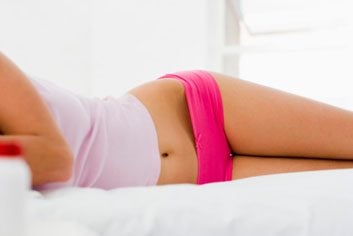
Is your period normal?
Even though the word “menstruation” comes from the same Latin root as “moon” and “month,” menstrual periods are rarely as regular and predictable as lunar cycles. In fact, it’s very common for them to change throughout your reproductive years. They’re a reflection of your physical and emotional health and your hormonal shifts. So the timing, flow and duration you have in your teens and 20s can alter in your 30s, then morph again in your 40s. You might find yourself suddenly cramp-free, or puzzled at irregular cycles, or worried when you need super-absorbent pads.
From puberty to menopause, you will probably spend the equivalent of about five entire years dealing with your period, so it’s important to know which changes are normal (most are) and which should prompt a talk with a health professional.

Your period in your teens and 20s
What’s typical: Random, irregular and crampy periods are par for the course in adolescence and early adulthood. True, the “average” menstrual cycle (counting from Day 1 of one period to Day 1 of the next) is 28 days with bleeding that lasts for four days, according to the Society of Obstetricians and Gynaecologists of Canada. But it can take 10 to 12 years after the first period-which normally happens anywhere from age 10 to 14-for the coordination of a young woman’s reproductive system to “grow up” into something resembling regularity, says Dr. Jerilynn Prior, a Vancouver endocrinologist and the scientific director of the Centre for Menstrual Cycle and Ovulation Research at the University of British Columbia. So it’s normal for cycles to fluctuate anywhere from 21 to 35 days, and for bleeding to last between two and six days, says Prior.
Painful cramps are practically a hallmark in this age group, affecting many females under age 30. Renesha Monaco, 22, of Toronto, gets debilitating cramps the first day of every cycle. “I have to schedule my life around my period, and usually I can’t work,” says the radio promotions rep. “My fiancé’s mother says she went through the same thing until she had a baby.”
Monaco’s future mother-in-law is on to something, says Prior. “Menstrual cramps are related to higher pressure inside the uterus as the muscle of the uterine wall contracts with flow. Younger women who haven’t had a pregnancy or worn an IUD have a tighter cervix, and this generates greater pressure and more cramps.” But even women who haven’t been pregnant may experience improvement after age 30. Prior says there’s emerging research that younger women’s cycles involve higher estrogen and lower progesterone levels.
This hormonal environment encourages the formation of prostaglandins-fatty acids that promote uterine contractions, causing cramps. Prior says the key is staying ahead of the pain. “When you get that heavy pelvic feeling-even before the cramps start or pain starts-take two ibuprofen, then a regular dose every four to six hours.”
It’s not unusual for young women to also have lengthy dry spells. “I didn’t have my period for the whole nine months of my first year of university,” says Prior. Causes of skipped or late periods (besides pregnancy) include stress from a major change, breakup or illness; an eating disorder; or simply not getting enough calories or protein. Scanty periods-meaning they last little more than one or two days and you need only a panty liner-could be quite normal in a thin, active young woman. If you’re on oral contraceptives, mid-month spotting is usually the result of a low-dose pill or a skipped pill.
Causes for concern: Get checked out for any new pelvic pain, especially at other times in your cycle. “You need to rule out sexually transmitted infections and pelvic inflammatory disease as well as the possibility of underlying issues including endometriosis and even irritable bowel syndrome,” says Jennifer Tomiuk, nurse practitioner at the Women’s Health Clinic in Winnipeg.
If your cycle is normally longer than 35 days or you go for months without a period (and you’re not pregnant or breastfeeding), you may not be producing enough estrogen, leaving you at risk for future bone loss. Or it could be thyroid disease, diabetes or polycystic ovarian syndrome, which can all cause missed periods, Tomiuk advises.

Your period in your 30s
What’s typical: Your early to mid-30s may well be your most regular years (outside of pregnancy) as your hormones settle into somewhat more predictable patterns. “The 30s are sort of the gold standard of periods,” says Prior. “But even then, there can be quite a bit of variation.”
Erika Shrestha, a 37-year-old mother of two in Newmarket, Ont., could set a clock by her periods. “They come every 28 days, practically right to the hour,” she says. “But I have wicked PMS the day before-just nasty. I’m an axe murderer!” The moodiness, sore breasts, bloating, food cravings and sleep problems typical of premenstrual syndrome can worsen in the late 30s if ovulation becomes more erratic, causing estrogen to zoom up, then go into free fall. Cutting back on salt, caffeine and stress may help, according to researchers at the Mayo Clinic.
If you suffer from cramps, try ibuprofen, which Prior says can not only reduce pain but also decrease flow by one quarter to one half. If heavy flow is a problem, she suggests starting with ibuprofen at the start of ovulation to prevent the formation of prostaglandins. A particularly heavy period that’s not part of your usual pattern could signify that you didn’t ovulate that cycle or even that you had an early miscarriage before you knew you were pregnant.
Cramps tend to ease up considerably in this decade, unless you develop endometriosis, a condition in which cells from the uterine lining grow outside the uterus. “Endometriosis can cause heavy, crampy periods,” says Tomiuk. It’s more common in women over 30, doesn’t necessarily require medical intervention and resolves itself in menopause, when estrogen decreases. If it doesn’t improve, drug therapy, such as hormones, is an option. Surgery, including uterine ablation and hysterectomy, is effective, but an absolute last resort for endometriosis.
Causes for concern: Mid-cycle spotting, if not from a missed contraceptive pill, could suggest a cervical polyp, a usually benign lesion that’s detected in a pelvic exam and is easily removed.
Periods that become less regular in the 30s may signify premature ovarian insufficiency, which is linked to early menopause. For most people it’s not a problem, but if you’re seeking help for infertility issues, keep a record of the timing of your periods.

Your period in your 40s
What’s typical: Longer, shorter, heavier, lighter-change is the name of the game now as you head into perimenopause, the six to 10 hormonally haywire years that precede the end of menstruation. You may find that your periods are coming every three weeks or, conversely, arriving further apart. Then, bingo, you’re suddenly back on schedule for a few cycles-until you go off-track again. Your PMS symptoms could intensify, with some cycles worse than others. Same with cramps; you may now experience pain that radiates into your back and down your thighs, likely due to estrogen levels spiking and plummeting while ovulation becomes intermittent.
As you get older, you’re more likely to develop one of the annoying but generally benign conditions that subside after menopause. Adenomyosis occurs when the uterine lining grows into the uterus’s muscular wall; while it’s harmless, it may cause very painful, prolonged, heavy periods. It’s different from endometriosis but the two may co-exist, and both improve after menopause when the condition may stop progressing, eliminating symptoms. Adenomyosis is especially common among women who have had C-sections. If over-the-counter pain relievers and heating pads don’t help, seek medical advice, says Tomiuk.
One in four perimenopausal women has flooding-a heavy, gushing flow that is sometimes accompanied by clots. It’s a medical problem only if you’re soaking more than one pad or tampon every hour for several hours and if clots are larger than a loonie.
While about half of all women under age 50 have fibroids-benign growths in the uterus that are most common in your 40s- “fibroids rarely cause heavy flow,” says Prior. She adds that in a study of 91 women who had had hysterectomies because of heavy bleeding, only six showed any evidence that fibroids may have been a contributor.
Causes for concern: By age 43, Pat Chiappetta found that her periods were lasting only a day or two and were pain-free but involved heavy bleeding that even extra-absorbent pads couldn’t contain. “Once when we had company over, I stood up and I had soaked the chair,” recalls the public health nurse from Aurora, Ont. “It was most embarrassing.” Over the next several months she became increasingly exhausted, despite taking iron supplements for anemia. On three occasions she passed out and was taken to three different hospitals. Each time, doctors ruled out heart problems and sent her home.
Finally she received a referral to a gynecologist, who diagnosed her with hyperplasia (an unusually thickened uterine lining) and performed an in-office uterine ablation, scraping away the lining. “Almost overnight, ?I went from tripled-up maxi-pads to panty liners.” Chiappetta, now 53, adds, “I’m a nurse and I should have known better, but no doctor ever asked me to describe my periods and I think that’s an important question physicians should ask.”
Prior and Tomiuk agree: If your bleeding persists in being unusually heavy, if you have any new or increased pain, or if your PMS overwhelms you, get medical advice.

The 50-plus flow
The average age of menopause (the point at which you’ve had no periods for one year) is 51, which means that many women are still menstruating well into their 50s-and many women stop well before their 50th birthday.
If you’re in your 50s and you’ve gone a year with no periods but then start bleeding, you may want to talk to your health professional. “Because a rogue period could indicate cancer of the endometrium, it is important to figure out if it’s normal or not,” says Prior. (Which it most likely is: Prior says 10 percent of post-menopausal women in their 50s, and 20 percent of post-menopausal women in their 40s, will have a rogue period after having none for more than a year.) She recommends paying attention to how you felt before the flow-if you had bloating, sore breasts, mood swings or other symptoms, the bleeding is probably normal.
Other causes of vaginal bleeding at this stage include atrophic vaginitis (dryness and thinning of vaginal tissue) and endometrial hyperplasia (overproduction of cells in the uterine lining). But it’s probably your ovaries making a diva comeback, and that’s not unusual at all. Check with your doctor, just to be sure.
Related:
• 3 ways to relieve PMS
• Is it safe to stop your period?
• 6 things you should know about IUDs
